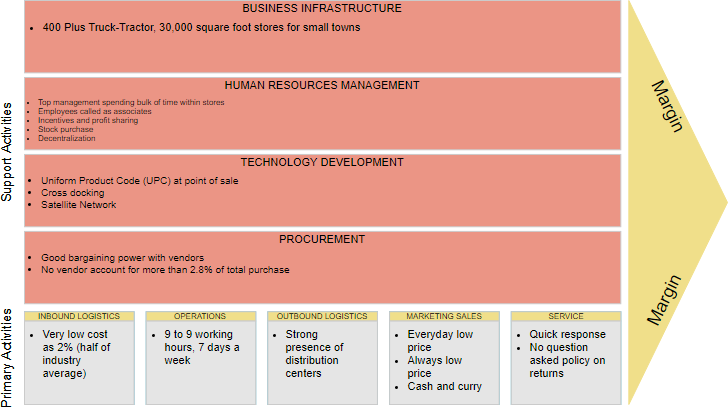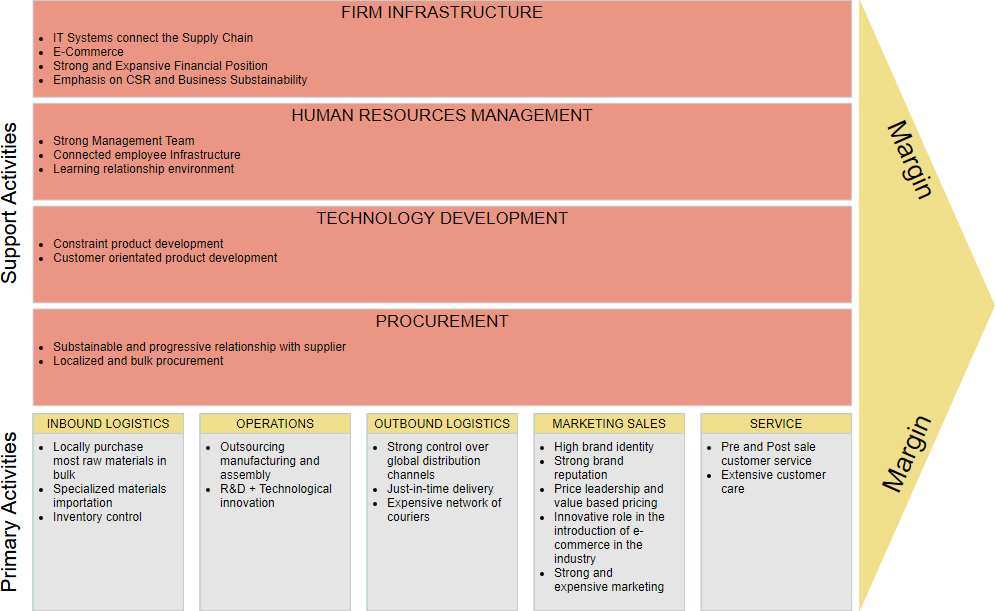Value chain analysis is a way to visually analyze a company's business activities to see how the company can create a competitive advantage for itself. Value chain analysis helps a company understands how it adds value to something and subsequently how it can sell its product or service for more than the cost of adding the value, thereby generating a profit margin. In other words, if they are run efficiently the value obtained should exceed the costs of running them i.e. customers should return to the organisation and transact freely and willingly.
Originated in the 1980s by Michael Porter, value chain analysis is the conceptual notion of value-added in the form of a value chain. He suggested that an organisation is split into 'primary activities' and 'support activities'. The figure below divides activities into primary and support activities as suggested by Porter's Value Chain Analysis model:

Value Chain Analysis is mentioned extensively in the first half of the book "Competitive Advantage" in 1985 by Michael Porter. Porter suggested that activities within an organisation add value to the service and products that the organisation produces, and all these activities should be run at optimum level if the organisation is to gain any real competitive advantage. Competitive Advantage is the ability for a firm to put "generic strategy" into practice, generic strategy includes:
What activities a business undertake is directly linked to achieving competitive advantage.
For example:
Value is the total amount (i.e. total revenue) that buyers are willing to pay for a firm's product. The difference between the total value and the total cost performing all of the firm's activities provides the margin.
Margin implies that organizations realize a profit margin that depends on their ability to manage the linkages between all activities in the value chain. In other words, the organization is able to deliver a product / service for which the customer is willing to pay more than the sum of the costs of all activities in the value chain.
A value chain concentrates on the activities starting with raw materials till the conversion into final goods or services. The sources of the competitive advantage of a firm can be seen from its discrete activities and how they interact with one another. The ultimate goals in performing value chain analysis are to maximize value creation while also monitoring and minimizing costs.

These discrete activities involve the acquisition and consumption of resources - money, labour, materials, equipment, buildings, land, administration and management. How value chain activities are carried out determines costs and affects profits.
Most organizations engage in hundreds, even thousands, of activities in the process of converting inputs to outputs. These activities can be classified generally as either primary or support activities that all businesses must undertake in some form.
Primary activities are directly concerned with creating and delivering a product. They can be grouped into five main areas: inbound logistics, operations, outbound logistics, marketing and sales, and service. Each of these primary activities is linked to support activities which help to improve their effectiveness or efficiency; and According to Porter (1985), the primary activities are:
Refers to goods being obtained from the organisation's suppliers and to be used for producing the end product.
Raw materials and goods are manufactured into the final product. Value is added to the product at this stage as it moves through the production line.
Once the products have been manufactured they are ready to be distributed to distribution centres, wholesalers, retailers or customers. Distribution of finished goods is known as outbound logistics.
Marketing must make sure that the product is targeted towards the correct customer group. The marketing mix is used to establish an effective strategy, any competitive advantage is clearly communicated to the target group through the promotional mix.
After the product/service has been sold what support services does the organisation offer customers? This may come in the form of after sales training, guarantees and warranties.
With the above activities, any or a combination of them are essential if the firm are to develop the "competitive advantage" which Porter talks about in his book.
Support activities assist the primary activities in helping the organisation achieve its competitive advantage. There are four main areas of support activities: procurement, technology development (including R&D), human resource management, and infrastructure (systems for planning, finance, quality, information management etc.). They include:
Every organisations needs to ensure that their finances, legal structure and management structure work efficiently and helps drive the organisation forward. Inefficient infrastructures waste resources, could affect the firm's reputation and even leave it open to fines and sanctions.
The organisation will have to recruit, train and develop the correct people for the organisation to be successful. Staff will have to be motivated and paid the 'market rate' if they are to stay with the organisation and add value. Within the service sector such as the airline industry, employees are the competitive advantage as customers are purchasing a service, which is provided by employees; there isn't a product for the customer to take away with them.
The use of technology to obtain a competitive advantage is very important in today's technological driven environment. Technology can be used in many ways including production to reduce cost thus add value, research and development to develop new products and the internet so customers have 24/7 access to the firm.
This department must source raw materials for the business and obtain the best price for doing so. The challenge for procurement is to obtain the best possible quality available (on the market) for their budget.
As mentioned before, primary activities add value directly to the production process, but they are not necessarily more important than support activities. Nowadays, competitive advantage mainly derives from technological improvements or innovations in business models or processes. Therefore, such support activities as 'information systems', 'R&D' or 'general management' are usually the most important source of differentiation advantage. On the other hand, primary activities are usually the source of cost advantage, where costs can be easily identified for each activity and properly managed.
Value chain analysis is based on the principle that organisations exist to create value for their customers. In the analysis, the organisation's activities are divided into separate sets of activities that add value. The organisation can more effectively evaluate its internal capabilities by identifying and examining each of these activities. Each value adding activity is considered to be a source of competitive advantage.

The figure below shows another Value Chain Diagram example.
